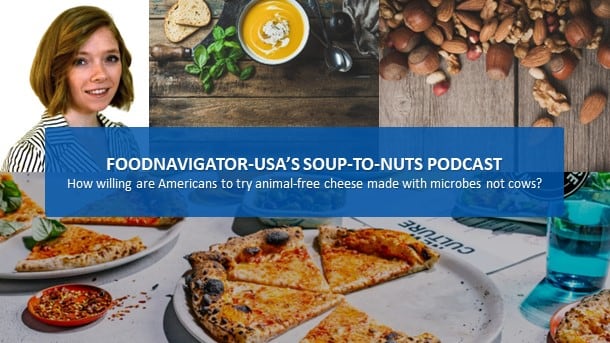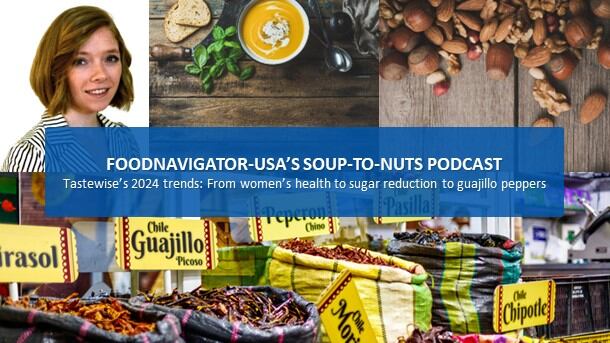In response, according to ADM’s recently published report Farming for the Future: The State of Regenerative Agriculture Program Adoption, nearly three-quarters of CPG executives and 47% of retailers say they have adopted some form of regenerative agriculture program. Of those that do not yet have a program in place, 65% say they plan to adopt a regenerative agriculture program within the next five years – but to do so successfully, many agree they need the right partners, including those with long-standing sustainability track records, strong farmer connections and expansive supply chains.
This can be a tall order for a the relatively small but fast-growing approach to agriculture and business, but one that ADM is striving to fill by working with partners across the value chain to test and share best practices, offer financial support and technical innovation and establish industry-leading standards that are flexible but effective.
In this episode of FoodNavigator-USA’s Soup-To-Nuts Podcast, ADM Director of Climate Smart Ag Origination Paul Scheetz shares how ADM is approaching and advancing regenerative agriculture, how consumer perceptions are influencing the movement and how CPG companies and retailers are responding.
[Editor’s note: Never miss an episode of FoodNavigator-USA’s Soup-To-Nuts podcast – subscribe today.]
Consumer interest is driving development of regenerative agriculture practices
According to ADM’s proprietary consumer insights platform, Outside Voice, nearly three-quarters of US consumers believe most of their food and beverages should be sustainably sourced and more than 65% say they are more likely to purchase products that are sustainably sourced.
Likewise, even though many consumers may not know what regenerative agriculture entails now, when it was explained to them, ADM found their perception, trust and purchase intent all increased – suggesting the practice would reinforce business resilience.
Specifically, ADM found after a definition of regenerative agriculture was offered consumers, 73% agreed they would be more likely to trust retailers and brands that implemented the practices and 72% agreed they would be more likely to purchase from them.
As ADM’s research revealed, many retail and CPG companies are responding by exploring and adopting some form of a regenerative agriculture program, but as Scheetz explained regenerative agriculture is still in its infancy and building it up in a way that meets consumer demands, delivers real environmental impact and offers commercial benefits across the supply chain requires partnerships, pilots and patience.
For its part, ADM began working with partners in 2012 and 2013 to better understand the potential of regenerative agriculture, identify best practices and develop a working definition that could serve as the foundation for communication with consumer as well as stakeholders across the supply chain.
Initially, ADM began with a pilot programs in Iowa and Kansas in which it examined the environmental and output impacts of tillage, fertilizer plans, and cover crop adoption, which outside research suggested could have the most positive impact, Scheetz said.
“We wanted to identify those trends and try to put programs together that incentivized farmers to continue to adopt or accelerate adoption of [what they already were doing that was positive] because every single one of those decisions … either has productivity or cost concerns around it,” he explained. As such, he added, there needs to be incentives to offset investments.
Drawing on these findings and working with other stakeholders ADM ultimately defined regenerative agriculture as practices based on indigenous ways of land management that are adaptive to local and physical conditions and culture.
Within this, Scheetz said, the company has five main principles of regenerative agriculture:
1) Minimizing soil disturbance,
2) Maintaining living roots and soil,
3) Continuously covering bare soil,
4) Maximizing diversity within crops, soil microbes and pollinators, and
5) Responsibly managing inputs, including nutrients and pesticides.
Partnerships are fundamental to broad change, long-term success
Given the trial-and-error nature of testing and identifying best practices to meet each element of this definition for regenerative agriculture as well as the increased costs associated with implementation, Scheetz said ADM quickly realized that just as it could not define regenerative agriculture alone it also needed partners to scale it from logistical, technical and financial standpoints.
“One thing that we learned early on is this isn’t something that we can do on our own. Each part of the supply chain plays an integral part of understanding what their core capabilities are. And also, it is going to require partnerships that are maybe outside of our current supply chain, as well, to help us ultimately get to the end goal, which is supporting farmers adopting practices that have positive environmental impacts,” Scheetz said.
ADM quickly teamed with technical experts with agronomic expertise who could assist farmers in location and condition specific best practices as there is no standard best practices for adopting cover crops, for example, he said.
Another essential partnership was with technical experts that could help collect field level information and assist in reporting the impacts that are associated with them, Scheetz added.
Equally critical to the technical expertise and involvement of partners at the front-end of the supply chain are those downstream, including CPG companies, according to Scheetz, who called out early efforts by Unilever and PepsiCo as examples of how manufacturers and brands can become involved.
Regenerative agriculture must offer commercial opportunities
A key component of scaling regenerative agriculture is financial support from CPG manufacturers and those downstream for farmers who cannot bear the brunt of the initial investment, said Scheetz.
“For regenerative agriculture programs to be successful, it can’t just be a compliance exercise. It has got to be a business and commercial opportunity exercise across the whole supply chain,” and it must start with the farmer, he explained.
To incentivize farmers, ADM worked with CPG companies to offset productivity concerns and investments with incentives. As supply builds and demand increases, CPG companies and others downstream will be able to recoup those investments through product differentiation and added value for the consumer, he added.
Looking forward, Scheetz says more involvement by governments, banks, insurers and retailers will be essential to continue scaling regenerative agriculture and maximize its impact.
3 steps to start regenerative agriculture practices
For those who want to support regenerative agriculture – and benefit from its long-term potential – Scheetz shares three initial steps.
“It always starts out with doing an analysis and trying to identify what your footprint is – either carbon footprint or water footprint and getting a little bit more familiar with what your supply chain looks like,” he said.
The next step is to engage with suppliers and identify where their opportunities are, he said, noting that regenerative agriculture is not one size fits all and practices will need to be tailored to different locations and crops.
The third step is to remain open-minded and track innovative advancements which could facilitate additional improvements, said Scheetz, noting there is not silver bullet to solve the environmental challenges associated with farming and agriculture.
“There are always going to be continuous improvement opportunities that allow the agriculture supply chain to differentiate itself,” he explained.
Scheetz also emphasized that the regenerative agriculture movement is growing and evolving quickly, which means if stakeholders tried to get involved even just three years ago but were stymied, they should try again and do so with an open mind towards partnerships.
“Understand that today is completely different than what it was three years ago, and the way the space is today, it is a super collaborative effort as well. We are all working in the same direction and might have slightly different opinions of how to ultimately get there, but will ultimately lead to an even better relationship that you have either with your customer or your suppliers than you’ve had in the past,” he said.




